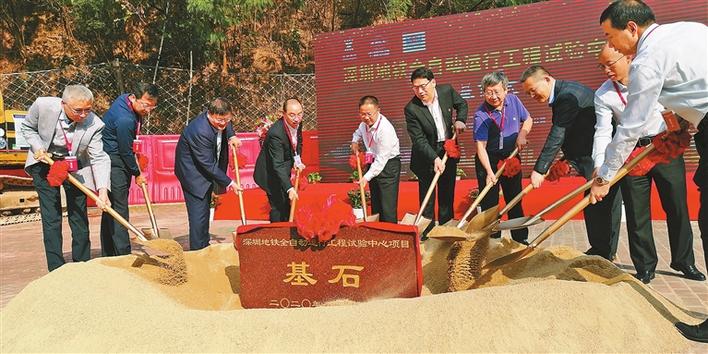
The foundation stone-laying ceremony for Shenzhen Metro Fully Automated Operation Test Center in Nanshan District yesterday. Construction on the center kicked off yesterday, marking Shenzhen’s entrance to an era of driverless Metro trains. Sun Yuchen
Shenzhen will join the list of cities across the globe embracing a world of driverless trains as construction on Shenzhen Metro Fully Automated Operation Test Center officially started at Shenyun Depot in Nanshan District yesterday.
With a floor space of 4,200 square meters, the center will be equipped with GoA4 (Grade of Automation 4) transport system, in which trains are capable of operating automatically at all times, while also being able to open and close doors, detect obstacles and react to emergencies. The center will be put into use in June 2021.
The center simulates actual scenarios of driverless operation of Metro trains. It will have a station, test center, automated operation technology exchange center and integrated test area.
As a key project in the city’s rail construction, the center is equipped with cloud technologies and communication functions between trains.
“The center with cutting-edge technologies will offer support for the operation of driverless lines in Shenzhen, and further improve safety and efficiency of the city’s Metro operation system,” Tang Shaojie, general manager with Shenzhen Metro Group, said yesterday.
The driverless technology will be piloted on Metro Line 20, a rapid transit rail line connecting Terminal 4 of Shenzhen Bao’an International Airport with Shenzhen World Exhibition & Convention Center, and later on Line 12, 13, 14 and 16 that will be put into operation in 2022, according to the group. By then, the total Metro rail network in Shenzhen will expand to 568 kilometers in total.
Shenzhen plans to have 33 Metro lines in operation with a total length of 1,335 kilometers in 2035.
Fully automated Metro lines offer numerous advantages over their human-controlled counterparts.
Metro lines with unattended train operations can reduce required manpower by 30-70 percent, achieve higher frequency, increase space for passengers and improve reliability by over 50 percent, as per Alstom, a world leader in integrated transport systems.
In 2018, the International Association of Public Transport found 42 cities around the world ran 64 fully automated lines, with over 50 percent of them in Asia.
In China alone, 32 fully automated Metro lines will be entering service across 16 cities by 2022.
Around the globe, automated rail networks run on purpose-built lines such as Singapore’s MRT service, or under hybrid systems where automated rail services co-exist with manually driven ones such as London’s Underground and the Sydney Metro.



